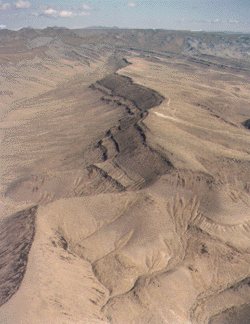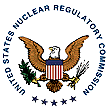
|
|

|
|
The State of Nevada consolidated its major Yucca Mountain lawsuits into four main cases: The "Recommendation" lawsuit (which consisted of the "EIS" lawsuit and the "Guidelines" lawsuit), the "EPA" lawsuit, the "NRC" lawsuit, and the "Constitutional" lawsuit. All of these cases were argued in front of the U.S. Court of Appeals in Washington, D.C. on January 14. Click for more on the hearing and on the judges' decision. What follows is a brief summary and the main points of each case. Recommendation Lawsuit The Recommendation Lawsuit is a consolidation of the EIS (Environmental Impact Statement) and Guidelines lawsuits. EIS Lawsuit The EIS lawsuit was filed by the State of Nevada on June 6, 2002, against Secretary of Energy Spencer Abraham and President George W. Bush. The suit challenges the DOE's Final Environmental Impact Statement (FEIS) on the Yucca Mountain repository. The State of Nevada contends the FEIS violates the National Environmental Policy Act (NEPA) and the Nuclear Waste Policy Act (NWPA). The suit also challenges Abraham and Bush's decisions to recommend Yucca Mountain based on the FEIS. Nevada cites multiple deficiencies of the DOE's Final Environmental Impact Statement. Among other things, the FEIS:
The lawsuit also points out that the FEIS fails to disclose whether the Yucca repository will be high-temperature or low-temperature. This is a pivotal decision that will determine the entire structure and physical layout of the repository. The suit also alleges that Energy Secretary Abraham deliberately withheld the FEIS from Nevada and the public. Abraham released the FEIS with his recommendation to the President, violating NEPA regulations by not providing a mandatory 30-day public review period. The lawsuit concludes that the Final Environmental Impact Statement is full of crucial information gaps, ignores public concerns, and does not adequately predict the impacts of a Yucca Mountain high-level waste repository. Nevada also challenges President Bush's approval of the site based on the faulty FEIS. Guidelines Lawsuit (part of the "Recommendations" suit) Another lawsuit Nevada has filed against the Department of Energy concerns DOE guidelines about Yucca Mountain geologic suitability.  When the Nuclear Waste Policy Act (NWPA) was originally written in 1982, both Congress and DOE agreed that deep geologic isolation was the required form of containment for the nation's high-level nuclear waste. Nuclear waste remains highly radioactive for hundreds of thousands of years, and no known form of man-made barrier or container is capable of serving as a reliable and safe permanent waste container for that long. Consequently, NWPA expressly mandated that geologic considerations be the "primary criteria" for the selection of the repository site. When the Nuclear Waste Policy Act (NWPA) was originally written in 1982, both Congress and DOE agreed that deep geologic isolation was the required form of containment for the nation's high-level nuclear waste. Nuclear waste remains highly radioactive for hundreds of thousands of years, and no known form of man-made barrier or container is capable of serving as a reliable and safe permanent waste container for that long. Consequently, NWPA expressly mandated that geologic considerations be the "primary criteria" for the selection of the repository site.DOE's guidelines for selection of the site originally reflected this mandate. In the Yucca Mountain Mission Plan, DOE stated its intent to "place primary importance on the capabilities of the natural system for waste isolation." However, in 1999, the DOE "rewrote" its guidelines to rely primarily on engineered waste packages, not on geologic disposal. The lawsuit, filed on December 17, 2001, contends that after several years of study, the DOE discovered Yucca Mountain was not geologically suitable due to water infiltration, seismic activity, and volcanism. However, instead of notifying Congress and the Secretary of Energy that Yucca Mountain was unsuitable, the DOE merely changed the rules by rewriting their guidelines. Nuclear industry lobbyists even tried to convince Congress to change the law by altering NWPA's geologic suitability guidelines. They were unsuccessful. EPA Lawsuit  The Department of Energy is not the only agency being sued by Nevada, however. Nevada filed a lawsuit against the Environmental Protection Agency (EPA) on June 27, 2001. The Department of Energy is not the only agency being sued by Nevada, however. Nevada filed a lawsuit against the Environmental Protection Agency (EPA) on June 27, 2001. The EPA was responsible for setting the health and safety standards for residents living near the Yucca Mountain site. Energy Secretary Abraham calls these standards 'safe' and extremely 'stringent'. However, the State of Nevada contends the EPA's standards do not adequately limit radiation exposure. The standards would allow DOE to use 18 kilometers (11 miles) of the Amargosa aquifer for dilution and dispersion of radiation from the repository. Nevada also claims the EPA did not take into account future growth rates and other changes while predicting future impacts on Nevadans living near the site. Notably, in the 2000 census, Nevada was shown to be the fastest growing state in the nation. The lawsuit contends that by failing to set adequate health and safety standards for Yucca Mountain, the EPA violated the Nuclear Waste Policy Act and other laws.  NRC Lawsuit NRC LawsuitIn conjunction with Clark County and the city of Las Vegas, the State of Nevada has additionally filed a lawsuit against the Nuclear Regulatory Commission (NRC). The NRC is responsible for granting licenses to DOE for construction and operation of Yucca Mountain. This case says the NRC acted illegally in revising regulations that govern the criteria to be used for licensing the Yucca Mountain repository. Among other things, the State contends that the NRC:
Constitutional Lawsuit Nevada filed its last lawsuit to be included in these cases, a constitutional challenge against the federal government, on January 9, 2003. The lawsuit argues that by forcing the State to house nuclear waste against its will, the federal government is violating the State of Nevada's sovereign rights. In March 2003, the federal court in D.C. decided the case would be heard with the others. Court Hearing On January 14, 2004, Nevada presented arguments for its combined Yucca Mountain lawsuits to a 3-judge panel in D.C. Judges listened to arguments and asked questions during a 3 ½ hour session. According to Nevada officials, the judges had mixed reactions to the State's lawsuits during the January 2004 hearing. Judges Harry T. Edwards, David Tatel, and Karen LeCraft Henderson were skeptical about Nevada's claim that the Federal Government was violating the State's constitutional rights by constructing a repository against the State's will (Case No. 03-1009, the "Constitutional" Case). They seemed equally unconvinced by Nevada's arguments against the siting of the project (the "Recommendations" Case). However, the judges appeared to share Nevada's concerns over the Environmental Protection Agency's (EPA) Yucca safety standards. The case argues that the EPA's 10,000 year limit on radiation containment in the site is insufficient and illegal ("EPA" Case). The judges questioned the EPA sharply on its justification for the 10,000-year limit, especially given the National Academy of Sciences' (NAS) recommendation for a longer period. "NAS says there is no scientific basis for limiting it to 10,000 years," Judge Tatel said. "What could be more inconsistent with that academy's recommendation?" The State also won a concession from the Nuclear Regulatory Commission. Judge Edwards said that the State should be able to challenge the final environmental impact statement for the Yucca repository during the Commission's license hearings. This had not previously been an option, and Nevada attorneys said it would give them more ammunition in the licensing proceedings. The judges were left with extensive legal briefs and supporting documentation to consider before making decisions. To read about the judges' ruling, return to the litigation page. |
|
Site Index Documents | Regulation | Photos | Maps | EIS Data | Timeline Calendar | FAQ | Internet Links | Archives | Contact Site Map | Home Page — Search Our Site — Last Updated 09/2004 |